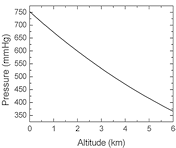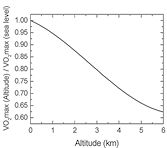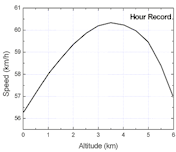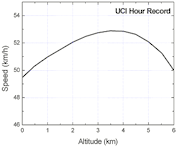The Hour Record at Altitude
Posted on 01. Pro, 2008 by admin in EXTRA, HODINOVKA
 It is well known that the air density decreases with an increase in altitude, which reduces the aerodynamic drag but also reduces the athletes power output.
It is well known that the air density decreases with an increase in altitude, which reduces the aerodynamic drag but also reduces the athletes power output.
r = 1.225 – (PB / 760) – (288.15/T)
The pressure PB follows the well known “barometric altitude equation”:
PB=exp(6.63268-0.112 – H – 0.00149 – H2
where PB is the barometric pressure in mmHg and H is the altitude in km (West 1996), which is shown in the figure on the right. If we assume that cycling records will be attempted at a temperature around 20 oC, the air density is just a function fo the altitude: So it is obvious to go as high as possible, isn’t it?
It’s not so easy, since the athlete’s ability to consume oxygen is comprised with an increase in altitude:
KA = (100.35 – 4.073 – H – 1.434 – H2 + 0.178 – H3 -0.35)/100
 where KA is the VO2max expressed as a percentage of VO2max
where KA is the VO2max expressed as a percentage of VO2max
at sea level (Basset et al. 1999), see figure on the right. So for example at 4 km altitude the athletes VO2max has decreased to about 70% compared to sea level.
Now we just have to modify our basic equations from the
Motion of a cyclist page
PAir = FAir – v = 0.5 -cwA-r-v3
with different values for r at different altitudes, the power output of the athlete PRider has to be reduced in parallel.
The result is the predicted hour record as a function of the altitude. The effect is clearly to see: If one takes the hour record at sea level of ca. 56 km/h, with increasing altitude the speed increases more an more, until a maximum of about 60 km/h is reached for an altitude of about 3700 m. At higher altitudes the velocity decreases again. Similar results (optimal altitude around 3000 m – 3500 m) were found also by other authors. So in principle the velodrome in La Paz (Bolivia) at 3400 m should be perfect. Its interesting that the Mexico City velodrome at 2230 m should already give an advantage of about 3 km/h!
For the UCI hour record the results are comparable, Chris Boardman’s attempt of 49.4 km/h would be around 52 km/h at Mexico City or even around 53 km/h at 3800 m. So, comparing Eddy Merckx at Mexico City and Chris Boardman or Ondrej Sosenka at sea level, this makes their records even more impressive.


References:
Basset et al. 1999: Med Sci Sports Exerc 31:1665-1676
Olds et al. 1995: J Appl Physiol 78:1596-1611
West 1996: J Apll Physiol 81:1850-1854
Taken from http://www.wolfgang-menn.de/altitude.htm
